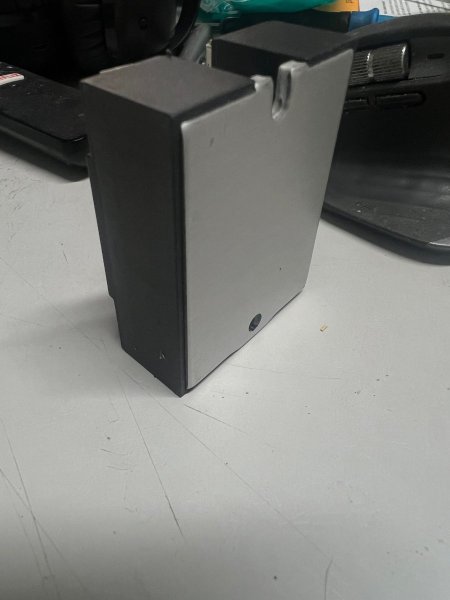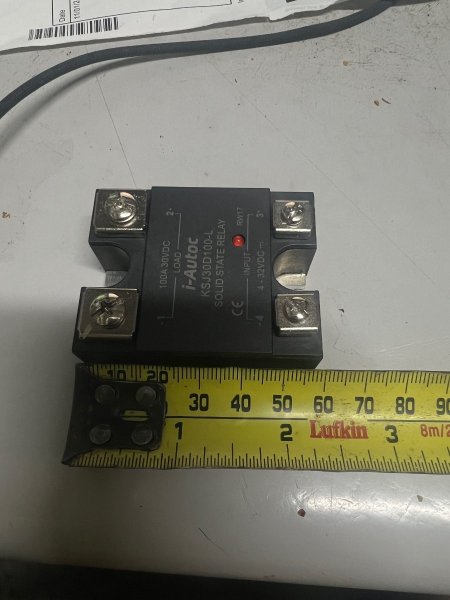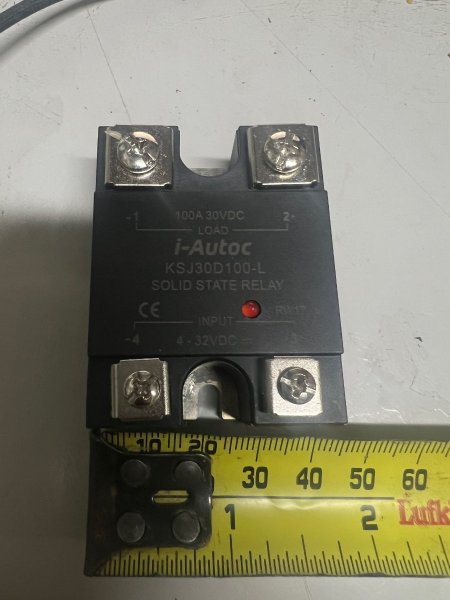-
Posts
6,583 -
Joined
-
Last visited
-
Days Won
93
Content Type
Profiles
Forums
Gallery
Downloads
Blogs
Events
Store
Aircraft
Resources
Tutorials
Articles
Classifieds
Movies
Books
Community Map
Quizzes
Everything posted by Kyle Communications
-
KR. either way they cost pretty much the same. I went with both being TSO versions...then there was no drama. had my money back in 4 weeks and if I wish I can now go into CTA with that hardware without any issue. You will never be allowed CTA with a SE2. So I just bit the bullet and did it the certified way then there was absolutely no issue. I looked at the financial differences and for me...it was worth the sh@t fight.
-
I am told ATC can see the SE2 as several plots have been called by ATC and they dont have mode C on board only SE2. But maybe in their MOP's ATC are not supposed to use it so who knows but ATC were supposed to be going to see them..it really is a software thing that would be easily implemented for ATC Mark
-
For ADSB out to comply it must have a proper certified GPS source. I bought the Uavionix TailbeaconX. They used to sell a "experimental" version of it but now only sell the TSO'd version. To comply you do need the GNSS certified GPS source. You can use another brand but I also bought the AV-30 from Uavionix which has that certified source inbuilt and fully complys. The AV-30 also does a hell of a lot of other stuff pretty much to the point you dont need a EFIS but any certified source comes at a price. basically the Transponder was about 4k and the AV-30 was about 4k..but with the rebate I got both of them for 4k...Also dont forget this is only ADSB OUT...for IN I will use my SE2..you turn off the transmitter and use the SE2 as your ADSB IN Or of course you can use another solution like a Raspberry Pi setup or a Stratus or one of the many others as your ADSB IN setup. I build my own aircraft and I just signed off the installation as me myself and I....There was no issue getting the rebate at all. Of course though you need the instruments all tested every 2 years by a licenced person to do so as I am not licenced to do that even though I spent 30 years in the radio/satellite comms industry doing board level repais and tuning and testing. I have never applied to get the necessary paperwork crap to get my licence to sign off on the avionics
-

New throttle system for Rotax
Kyle Communications replied to Kyle Communications's topic in Savannah
I should have some available in a week or so...just waiting on some main bars to be welded -
If you watched the video Nev they only want the motor back for a internal issue to find out why. Also to determine a fix or change to a process .Any thing else thats a bolt on is a replacment part
-
The video posted the other day said warranty was 3 years or 500 hrs..if it has a actual mechanical issue with the engine they will give you a new one and want to old complete engine back. Thats pretty good and shows they do want to make it a good engine..warranty with Rotax is always a fight and certainly not 3 years. I dont believe anyone in OZ has taken on a dealership yet but you would need a proper service and mech backup shop to do it correctly. If the engine was about 20k aussie then I think its very viable for that price certainly in the beginning of them trying to get units out there. I am not sure though of the current Floods price for a 912ULS but last time I heard it was 35k but dont forget that was no exhaust or oil cooler or radiater either..thats for a out of time swap engine
-
I enquired direct to Zongshen about them when they first appeared about 2 or 3 years ago..they wanted you to buy 4 engines to be a dealer and at the time they would have been about 28k aussie..the rotax was 32k aussie
-
26k US$ is about 38K aussie.....the rotax here is about the same price now
-
CKD ZS Engine – CKD Aero SHOP.CKD.AERO
-
The USA and Canada agent has pricing on the website and its only a couple of thousand less in the USA than a genuine rotax
-
They are not that much cheaper than a rotax though....if they were 10k cheaper then ok but they are only about 5k cheaper
-

MARAP FAILURE
Kyle Communications replied to GolfWhiskeyHotel's topic in Aircraft General Discussion
Yes it is a shame that you have been F@$ked over like this. yet there are a number of jabs flying that have had CAR35 i think it is. We had one at Caboolture airfield for a few years then it was sold. Not sure where it went to. I could find out if you want as I know the school operator. and it was RAA rego not GA I am sure. The new owner of jabiru hopefully sees the light and does one with a Rotax up the front hopefully he is not as pig headed as old Rodney about these things. They would sell a heap of Jabs with Rotax...there are still a lot of potential buyers out there that just dont trust the jab engine...I am not trying to start a flame war here just stating a fact. But now Stiffy is not the controlling partner maybe some improvements could be made as the Jab has been proved as a good safe airframe. -
I bought it to keep my bolly at the time in good nick for the engine. It has balanced quite a lot of engines now since I have had it. I have a L2 that borrows it a bit when servicing some aircraft even GA ones it has done. It was probably some overkill really for just my aircraft but at the time I was a bit flush and could spare the cost without a second thought. I of course do Eprop and they are all prebalanced but I dont think I would ever sell it. Its what I class as "test equipment"...There are some things I will never sell. That is all my very expensive RF test equipment and other electronic test gear also my lathe and my CNC Mill..There are some things once you manage to either fund or beg borrow or steal that you end up never selling. They only go when they are broken beyond repair or its by the execetor of your will....I think its a thing that most radio techs do. I bet if you ask RFGuy he doesnt get rid of his prized test equipment even if you only use it once a year 🙂
-
I have a dynavibe..they work well. Bought it secondhand for about 1200 quite a few years ago now.
-
No they are typically FETS..they are a voltage device rather than a current based device. Essentially they work like a switch when you place a voltage onto the gate and the drain and source then conduct. They are still semiconductors but they dont have any gain like a transistor does. I am trying to keep this as simple as I can because this subject is huge now. FETS are almost taking over the world 🙂 They are silicon switch for a better word. FETS are really common now and most of all your solar inverters and your power inverters etc..anything that switches on and off ans fast they are generally FETS now. They can take a crap load of current through them because their "on resistance" is very small. A lot of FETS have resistance across the junction like 0.28 of an ohm when turned on and even less. There is a mininum voltage that they turn on with but there is still a current limit as the junction resistance is not the lowest until the voltage gets to a higher level. There are so many types of FETS now its crazy...infact RF Output devices are commonly FETS now and are used regularly ...and I am talking lots of power. LDMOS type ones are regularly 1.5kw RF out Infact the main RF output device in a Xcom airband radio is a FET
-
The wattage loss is very low even at 10 amps (6 watts max) which would be the most current drawn from a dual efis system and ancillaries. That is only while it is turned on. With semiconductors the limiting factor is the device's junction temperature. The reason I dont like relays is it is drawing all your avionics load current through a spade terminal. I much prefer the screw/boltability of the SSR to take all the load. As a case in point just look how many Rotax regulators end up with burnt out spade terminals on the regulators...I would know of 20 or 30 at least...I dont like them odds...its just not a good thing..Thats why AC43 pretty much specifies ring terminal connections when possible
-

savannah incident
Kyle Communications replied to BrendAn's topic in Aircraft Incidents and Accidents
no he had a carb engine spring fail and the engine was running very rough so he put down on the island...emerg services came but they got it sorted and continued onto tasmania -

savannah incident
Kyle Communications replied to BrendAn's topic in Aircraft Incidents and Accidents
Where is Hogan Island?..There was a incident I know of in Bass Strait. but it wasnt a savannah -

Class 5 medical declaration. My experience
Kyle Communications replied to NT5224's topic in AUS/NZ General Discussion
I did mine a few weeks ago now...did the online stuff and filled out the stuff flashed my CC and literally 45 sec later my medical class 5 appeared in my email. Mark -
Nev I know the differences of each to me its the same result. Just different purposes. After 43 years as a electrical fitter mechanic special class ( industrial electronics) and also a radio tech....I think I know what versions are used for what tasks. Working on 11kv and 33kv and 110kv circuit breakers...using solenoid style actuation and distribution authority electrical substation protection and control systems using hundreds of relays also fault finding and contruction of those substation controls..The last 10 years also doing design and development of mains connected power electronics for mass production sets of products to me they are essentially the same just a different scale and type for the purpose. As I said its semantics to me. You just use the APPROPRIATE DEVICE for the job. As I stated I much prefer to use a manual isolation switch within my reach in the cabin rather than a solenoid to isolate a battery that I have my arse sitting in.
-
WEEEEELL it is semantics really. A relay is still a electromagnet coil and so is a solenoid. The solenoid is a much larger device designed to switch a much larger load and it does have a core that moves internally. The relay is pretty much exactly the same but in a smaller footprint and designed to handle a lot less current but it does the same thing. The relay though does tend to have a "switch" as contacts being NO and NC but there are exceptions where there is only one set of contacts which are NO similar to a solenoid. so it could be semantics or it could be definition..either way they both do the same thing. Yes you could have a solenoid working off a master switch in the aircraft that does isolate the battery. I have seen plenty of "solenoids" fail in my work life and to be honest I dont think I have ever seen a properly rated isolation switch fail. It is a peronal choice I suppose which way you want to go. To me I like the big manual switch right where it can be accessed from the pilot position.
-
When referring to a Master in a aircraft it usually means the main electric buss for the internal DC for the aircraft. Not the whole system for the aircraft including battery. I believe what you wanted was a isolation switch. I will always have a isolation switch for the very reasons you give above, That really is a given. The master is not that. It is just wordings I suppose and it all just means take accepted practices for making safe the whole electrical system in the aircraft. How far you want to go with that is up to the builder...and the rules of course. There is no requirement for a isolation switch in any aircraft...but it just makes good sense because if a fault like that occurrs you cant just get out of the vehicle at 7000 ft...unless you got a parachute on 🙂
-
The SSR I posted is NOT for the starter motor to use it is only for the MASTER..which is for the internal DC for aircraft. The starter has a usual generic solenoid/relay to take the many hundreds of amps at start. I would never use it to switch starter motor current. Semantics of wether it is a solenoid or a relay is nit picking words...we all know what it is and what it does









